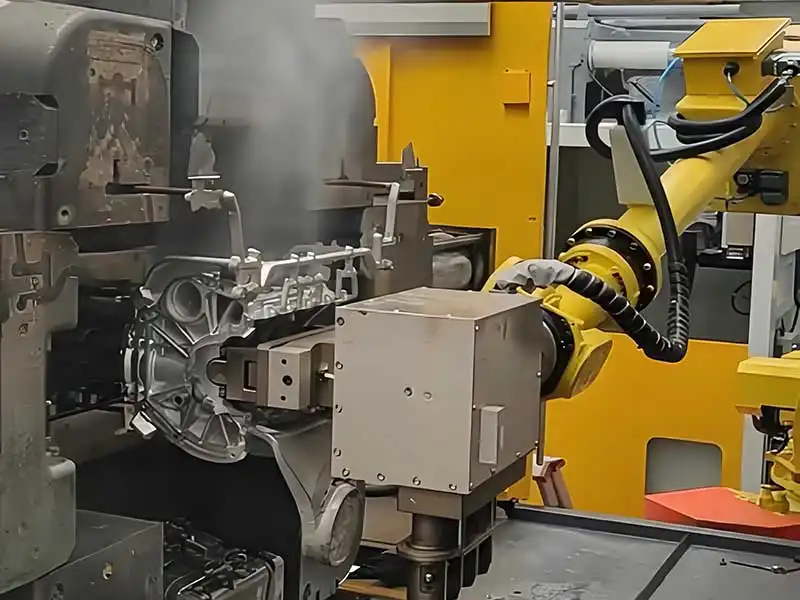Metal casting has been a cornerstone of modern manufacturing, enabling the production of complex, high-strength components at scale. Among the many casting methods available, High Pressure Die Casting (HPDC) stands out as a critical process in industries that demand precision, efficiency, and high-volume production.
This article explains the HPDC process in detail, covering its principles, advantages, limitations, materials, applications, and design considerations. The aim is to support engineers and designers in understanding the process and making informed decisions in material and process selection.

High Pressure Die Casting
What Is High Pressure Die Casting (HPDC)?
High Pressure Die Casting is a manufacturing process in which molten metal is injected under high pressure into a hardened steel mold (die), where it rapidly solidifies to form a precise, high-quality part.
Unlike low pressure die casting or gravity casting, HPDC employs pressures of up to 1500–2500 bar to force the molten metal into the die cavity at high speed. This allows for the production of intricate shapes with thin walls and excellent surface finish.
HPDC is most commonly used with non-ferrous alloys, including:
- Aluminium alloys
- Magnesium alloys
- Zinc alloys
These materials are chosen for their castability, strength-to-weight ratio, and performance in demanding applications.
How Does the HPDC Process Work?
Basic Principles
The core principle of HPDC is to use hydraulic pressure and fast injection speed to fill a steel mold completely before solidification begins. This ensures high dimensional accuracy and a dense, uniform microstructure.
Process Steps
- Die preparation: The steel mold is cleaned, preheated, and sprayed with a release agent.
- Melting: The metal alloy is melted in a furnace to the required pouring temperature.
- Injection: The molten metal is injected at high pressure into the mold cavity.
- Cooling and solidification: The metal cools rapidly in the mold, achieving high strength and fine grain structure.
- Ejection and trimming: The solidified part is ejected and excess material (flash) is removed.
Hot Chamber vs. Cold Chamber HPDC
- Hot chamber: The injection system is submerged in the molten metal. Used for low-melting alloys like zinc and magnesium.
- Cold chamber: The molten metal is ladled into the chamber before injection. Used for aluminium and copper-based alloys, which have higher melting points.
Advantages of High Pressure Die Casting
HPDC offers numerous benefits that make it highly suitable for mass production in demanding industries:
- High production efficiency: Rapid cycle times enable high-volume manufacturing.
- Dimensional accuracy and consistency: Tight tolerances and repeatability over thousands of parts.
- Superior surface finish: Parts often require little or no machining or finishing.
- Ability to produce complex geometries: Thin walls, intricate details, and integrated features can be cast in a single operation.
- Material efficiency: Minimal scrap and high material utilization rates.
- Cost-effectiveness for large runs: While the tooling investment is significant, per-unit cost drops significantly at high volumes.
Limitations of HPDCWhile HPDC is a powerful process, it has some constraints:
- High tooling cost: Initial die and equipment costs are substantial.
- Design constraints: Minimum wall thickness, draft angles, and ejector pin marks must be considered.
- Best suited for large volumes: Not economical for small production runs due to tooling investment.
- Potential defects: Porosity, shrinkage, and warping can occur if not properly managed.
Common Materials Used in HPDC
Several alloys are well-suited to the HPDC process:
- Aluminium alloys: Lightweight, corrosion-resistant, ideal for automotive and aerospace parts.
- Magnesium alloys: Extremely light, used in electronics and automotive components.
- Zinc alloys: Excellent castability, fine detail, and surface quality for decorative and mechanical parts.
- Other specialty alloys may also be used for specific performance requirements.
Applications of High Pressure Die Casting
HPDC is widely used across industries due to its versatility and efficiency:
- Automotive industry: Engine blocks, transmission housings, suspension components.
- Aerospace: Structural components where strength and weight are critical.
- Consumer electronics: Laptop cases, mobile phone frames, camera housings.
- Industrial machinery: Pumps, valves, and housing components.
- Home appliances and lighting: Decorative and functional parts.
Design Considerations for HPDC Parts
For successful HPDC parts, engineers must consider:
- Die design: Effective cooling channels, vents, and gate placement to minimize defects.
- Wall thickness and ribs: Uniform and optimized to reduce distortion and ensure fill.
- Defect control: Strategies to minimize porosity and shrinkage.
- Post-processing and finishing: Allowance for machining, coating, or plating if required.
Comparison with Other Casting Processes
| Feature | HPDC | Low Pressure | Gravity Casting | Sand Casting |
|---|---|---|---|---|
| Production volume | High | Medium | Low-Medium | Low |
| Tooling cost | High | Medium | Low | Very low |
| Tolerances | Tight | Moderate | Moderate | Loose |
| Surface finish | Excellent | Good | Fair | Poor |
| Complexity | High | Moderate | Moderate | Low |
HPDC is the preferred process when high-volume, high-precision, and fine surface finish are required.
Conclusion
High Pressure Die Casting is a highly efficient, precise, and cost-effective manufacturing process — particularly well-suited for producing large quantities of complex, lightweight metal parts.
Its unique combination of speed, quality, and versatility has made it indispensable in industries such as automotive, aerospace, and consumer electronics.
However, its high initial tooling cost and design constraints mean it is best suited for high-volume applications where its advantages outweigh the limitations.
Engineers should carefully evaluate product requirements, batch size, and design constraints before selecting HPDC as the preferred manufacturing method.
Frequently Asked Questions (FAQ)
Q1: Which materials are suitable for HPDC?
A: Aluminium, magnesium, and zinc alloys are the most common choices due to their excellent castability and performance.
Q2: How precise is HPDC compared to other processes?
A: HPDC offers tighter tolerances and better surface finish than sand or gravity casting, making it ideal for precision components.
Q3: Can HPDC be used for small-batch production?
A: It is generally not economical for small runs because of the high tooling costs. Other methods like sand casting may be more suitable in such cases.
Q4: What surface finishes are achievable?
A: HPDC parts typically have excellent surface quality and may require minimal finishing. Polishing, painting, or plating can also be applied if needed.


